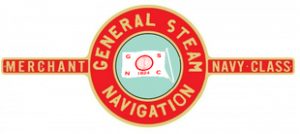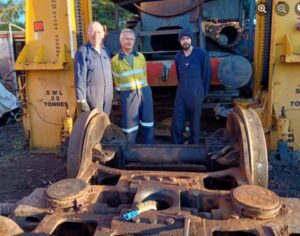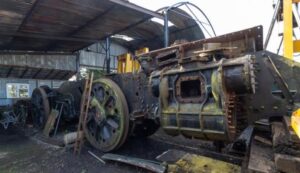
Summer Engineering Update
Welcome to this Summer 2023 engineering update from the General Steam Navigation project. Progress has been made on various engineering fronts on the project over the past few months and with some of our background efforts about to bear fruit we’ll have some brilliant work to share over the coming months.
Boiler
Since the last packet, there has been no further progress on the boiler, but we are working on scheduling the boiler washout. This was originally planned for February, but was postponed due to a combination of personal circumstances.
 Mother nature had a go at helping with the washout recently, but photos from inside the boiler show everything remains dry. The Boiler washout actually took place at the beginning of August with the grateful assistance of our friends within the Swindon & Cricklade Railway Steam loco department. Details of the Boiler Inspectors preliminary inspection report will be in the next issue of our Members Magazine The Packet, if you not already a member join here today to get the latest news first.
Mother nature had a go at helping with the washout recently, but photos from inside the boiler show everything remains dry. The Boiler washout actually took place at the beginning of August with the grateful assistance of our friends within the Swindon & Cricklade Railway Steam loco department. Details of the Boiler Inspectors preliminary inspection report will be in the next issue of our Members Magazine The Packet, if you not already a member join here today to get the latest news first.
Trailing Truck
Progress on the trailing truck has been slim since provided in the last Members Magazine The Packet, as the NNRE have had other tasks taking higher priority. Following the previous issue of The Packet, we have had some helpful insight into the weldability of gunmetal (and leaded gunmetal) which is proving very useful.
Crank Axle
Physical progress with the crank axle continues to be impacted by geopolitical events causing volatility in the price of steel, after discussions with our friends in the B17 Steam Locomotive Trust project & A1 Steam Locomotive Trust, with whom we were planning to place a group order for A4T forgings for the stub axles, we are pausing the ordering process until we have greater certainty over the price. Whilst it is disappointing to not be placing an order for these crucial parts of our locomotive, it feels more prudent to wait, saving us money in the long run. During this self-imposed delay, we continue to use the time to produce the engineering justification for manufacture of the stub axles in A4T & the sweep webs in 817m40, so that when we are happy with prices, we can proceed.
We are also continuing with the initial design of the new chain-driver sprocket to fit the balanced crank axle design. The design fitted to the original unbalanced crank won’t fit the balanced crank design, as the stub axles are wider & the mounting points were changed. There was a design for the sprocket for the balanced crank axle, but it is not in any drawing collection that we are aware of, and is assumed lost. The design we are working on will be based upon the original sprocket along with the mounting design for the eccentric fitted on rebuilding to drive the inner motion, as we know the mounting points were broadly the same.
Leading bogie
Work has started on taking off the removable parts of the bogie, to reduce the work that would be done when it is sent away. The key component is the side control unit.
 Our leading bogie was attached to the frames via a pin and bush arrangement, similar to the trailing truck. On both of these, the pin is firmly attached to the frame of the locomotive, but the bush can slide laterally within the side control unit. Either side of the bush is a spring in compression. As the locomotive enters a curve, the frames will want to continue in a straight line, whilst the bogie will follow the curve. This will compress the spring on the outside of the curve, and extend that on the inside of the curve, helping to steer the front of the locomotive through the curve. We have started taking the side control unit apart, so it can begin to be cleaned & restored.
Our leading bogie was attached to the frames via a pin and bush arrangement, similar to the trailing truck. On both of these, the pin is firmly attached to the frame of the locomotive, but the bush can slide laterally within the side control unit. Either side of the bush is a spring in compression. As the locomotive enters a curve, the frames will want to continue in a straight line, whilst the bogie will follow the curve. This will compress the spring on the outside of the curve, and extend that on the inside of the curve, helping to steer the front of the locomotive through the curve. We have started taking the side control unit apart, so it can begin to be cleaned & restored.
Frames
The main activity at recent working weekends, beyond the leading bogie, has been on the frames. As we will eventually need to remove all three cylinders from the frames as part of the process of replacing the middle one, we are starting to remove, clean and replace/refix all the nuts & bolts that hold the cylinders to the frames.
 This will mean that when we are ready to remove the cylinders, we should be able to detach them quickly. It will take some time to do this, but will save time in the long run. The middle cylinder is being replaced, with a new one to be manufactured to the original design, with outside admission. Removing the outer ones will make removing the middle one easier, and will give us the opportunity to
This will mean that when we are ready to remove the cylinders, we should be able to detach them quickly. It will take some time to do this, but will save time in the long run. The middle cylinder is being replaced, with a new one to be manufactured to the original design, with outside admission. Removing the outer ones will make removing the middle one easier, and will give us the opportunity to

 Originally fitted to a series 3 Merchant Navy, our fabricated trailing truck is the last survivor of its kind. Lighter than the cast truck fitted to the other preserved Merchant Navy locomotives, longer than a Light Pacific’s truck, the GSNLRS are having this unique piece of Bulleid locomotive design restored to mainline standard, a crucial step towards GSNLRS’s vision of an original Merchant Navy with original air smoothed casing and Bulleid’s patented chain driven valve gear.
Originally fitted to a series 3 Merchant Navy, our fabricated trailing truck is the last survivor of its kind. Lighter than the cast truck fitted to the other preserved Merchant Navy locomotives, longer than a Light Pacific’s truck, the GSNLRS are having this unique piece of Bulleid locomotive design restored to mainline standard, a crucial step towards GSNLRS’s vision of an original Merchant Navy with original air smoothed casing and Bulleid’s patented chain driven valve gear.